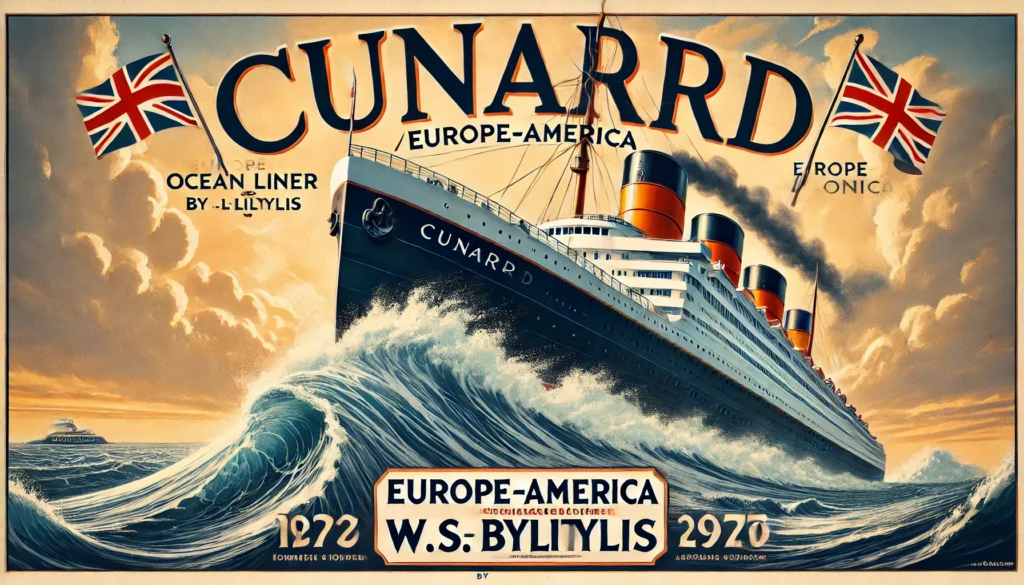The Cunard/Europe-America by W.S. Bylitylis is a vintage travel poster from the early 20th century. It was created around 1910 and was used as an advertisement for the Cunard Line, one of the most famous transatlantic shipping companies.
This poster captures the grandeur and prestige of ocean travel during that period. It depicts a powerful ocean liner sailing across the Atlantic, symbolizing speed, safety, and luxury.
Travel posters like this played a crucial role in early advertising strategies. They were designed to attract wealthy travelers, businessmen, and immigrants looking for a new life in America.
Today, Cunard/Europe-America by W.S. Bylitylis remains an iconic representation of maritime history. It is highly valued by collectors, museums, and historians interested in vintage travel art.
Background of the Cunard Line
The Cunard Line was founded in 1840 by Samuel Cunard. It became one of the leading transatlantic shipping companies, providing reliable and luxurious ocean travel between Europe and America.
During the early 1900s, the Cunard Line was known for innovation and excellence in maritime travel. Their ships were fast, well-built, and focused on passenger comfort.
The company faced strong competition from the White Star Line, which built the Titanic. However, Cunard maintained a strong reputation for safety and continued to dominate transatlantic routes.
By 1910, when the Cunard/Europe-America by W.S. Bylitylis poster was created, the company had already established itself as a leader in global ocean travel.
Overview of the Poster
The Cunard/Europe-America by W.S. Bylitylis poster showcases an impressive steamship crossing the ocean. The painting uses bold colors and dramatic lighting to highlight the power and speed of the vessel.
The background features a vast ocean with strong waves, emphasizing the ship’s stability and strength. This was an important message at the time, as passengers wanted safe and smooth journeys across the Atlantic.
Typography played a key role in the design. The Cunard name was displayed prominently in an elegant font, reinforcing the company’s prestige and authority in ocean travel.
The use of artistic realism made the poster both visually striking and persuasive. It successfully convinced people that traveling with Cunard was the best option.
| Poster Elements | Purpose |
| Large Ocean Liner | Shows power, luxury, and speed |
| Dramatic Waves | Emphasizes ship’s stability and safety |
| Bold Typography | Highlights Cunard’s prestige |
| Rich Colors | Makes the poster eye-catching |
Purpose and Impact of the Poster
The Cunard/Europe-America by W.S. Bylitylis poster was created as an advertising tool. Its goal was to attract both wealthy passengers and general travelers to sail with the Cunard Line.
Luxury ocean liners were a symbol of status and comfort. Wealthy passengers were drawn to first-class accommodations, fine dining, and entertainment offered on Cunard ships.
However, the poster also targeted immigrants traveling to America in search of a new life. At the time, many people from Europe were emigrating to the United States, and transatlantic travel was in high demand.
This marketing strategy made the Cunard Line one of the most successful shipping companies of its time. The poster played a role in boosting passenger numbers and securing Cunard’s place in maritime history.
W.S. Bylitylis – The Artist
Little is known about W.S. Bylitylis, the artist behind the Cunard/Europe-America by W.S. Bylitylis poster. He was likely a commercial artist specializing in travel and transportation advertisements.
Artists during the early 20th century played an important role in shaping public perception. Their posters needed to be eye-catching and informative, convincing people to choose specific travel options.
The work of Bylitylis fits perfectly with the era’s advertising trends. He used realistic imagery, dramatic color schemes, and bold lettering to create an effective promotional tool.
Despite limited records about him, Bylitylis contributed to the golden age of travel advertising, where posters were more than just art – they were persuasive marketing tools.
Legacy and Collectibility
The Cunard/Europe-America by W.S. Bylitylis poster is now considered a valuable collectible. It represents an era when ocean travel was the primary way to cross the Atlantic.
Many vintage travel posters from this time are now displayed in museums, galleries, and private collections. They provide insight into early marketing strategies and travel history.
Collectors often pay high prices for original copies of Cunard posters. These artworks have become rare and historically significant.
The legacy of Cunard/Europe-America by W.S. Bylitylis continues to inspire modern designers and historians, making it an important piece of maritime and advertising history.
Conclusion
The Cunard/Europe-America by W.S. Bylitylis poster is a remarkable piece of travel history. It highlights the luxury and reliability of Cunard ships, making it an effective advertisement for early transatlantic travel.
The Cunard Line played a major role in connecting Europe and America. Their posters helped shape the public’s perception of ocean liners as the best way to travel.
Even today, this vintage artwork remains an important part of maritime heritage. It is highly valued by collectors, museums, and historians.
The Cunard/Europe-America by W.S. Bylitylis is more than just an old advertisement; it is a symbol of a golden era in ocean travel.
FAQs
What is the Cunard/Europe-America by W.S. Bylitylis poster?
It is a vintage travel advertisement from around 1910, promoting the Cunard Line’s transatlantic voyages between Europe and America.
Who was W.S. Bylitylis?
W.S. Bylitylis was a commercial artist, likely specializing in early 20th-century travel and transportation posters.
Why was this poster important in 1910?
It served as an effective marketing tool, showcasing the luxury, speed, and safety of Cunard ships to attract travelers.
Where can I find an original Cunard/Europe-America by W.S. Bylitylis poster?
Original prints are rare collectibles and can sometimes be found in museums, private collections, or auctions.
Why is this poster still relevant today?
It represents the golden age of transatlantic travel, serving as both a historical artifact and a valuable piece of advertising art.

